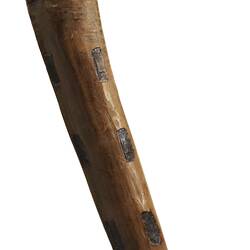Summary
Aboriginal men in Victoria, New South Wales and Queensland made this type of kallak (club). Known by different names in each area, it was used in single combat in conjunction with a small, flat-faced, angular-backed shield known as a mulga. The kallak was considered perhaps the most dangerous weapon of its type, as the point could be suddenly turned at the moment of striking.
The Gunai/Kurnai peoples have a strong historical and ongoing connection to the Gippsland region with many of their significant sites are associated with water resources. It is a testament to the Gunai/Kurnai people's relationship, knowledge of and respect for their Country that the Gippsland Basin bioregion is home to some of Australia's most pristine waterways. On 22 October 2010 the Federal Court recognised that the Gunai/Kurnai hold native title over much of Gippsland. On the same day, the State of Victoria entered into an agreement with the Gunai/Kurnai (Recognition and Settlement Agreement) under the Traditional Owner Settlement Act 2010.
Local Name
Kallak
Physical Description
A wooden boomerang shaped club. Proximal end is bulb shaped. Handgrip formed by a series of deep rings cut around the shaft of the club. Small rectangular areas have been burnt into the body of the club at even intervals. Some cracks in both distal and proximal end.
Significance
A hardwood sapling was chosen for the kallak's manufacture, with part of the root forming the head. It would be carved while the wood was still green, and would then be hardened over the fire or by rubbing it with lizard fat. The carved coiling at the base of the handle would have provided the warrior with a secure grip during battle.
The distinctive design incised on the body of this kallak is the same as the design on an associated club, providing an important historical record of a craftsman's use of design to identify his Country, work and weapons.
More Information
-
Object/Medium
Club
-
Maker
-
Locality
-
Date Produced
-
Collector
-
Object Measurements
620 mm (Length), 190 mm (Width), 30 mm (Height)
-
Classification
-
Date Made
-
Maker
-
Clan/Language Group
-
Place Made
-
Indigenous Region
-
Keywords
-
Collection Names
-
Type of item
-
Discipline
-
Category
-
Collecting Areas



